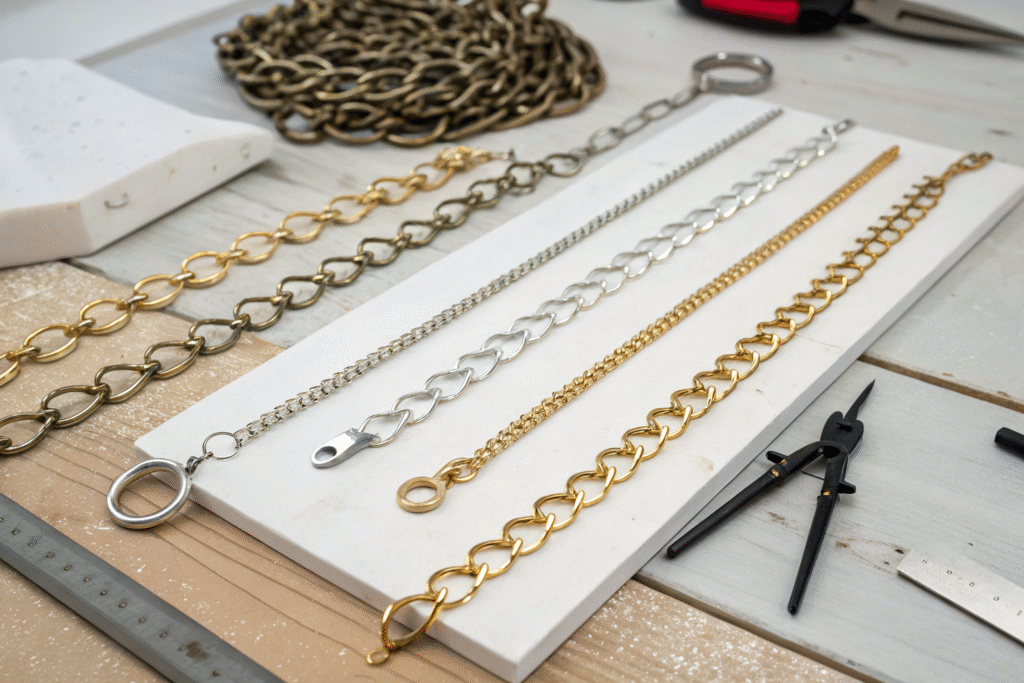I run HairAcc in China, and I sell hair chains to EU buyers who care about compliance. I hear the same fear from new clients. They like our styles, but they worry about REACH rules, nickel limits, and paperwork at customs. I understand this, because one late test report can stop a shipment. So I built a simple path that makes REACH easy, even for complex metal accessories.
I will answer the core questions first. REACH compliance for hair chains starts with material selection that limits nickel release and SVHC risk. Then testing against EN 1811 and screening for Annex XVII substances. Then full documentation: test reports, safety data where needed, supplier declarations, and SCIP if SVHC >0.1%. Last, packaging, labeling, and logistics plans that match EU practice.
Now I will show you how I control each step inside my factory group. I will also share checklists you can copy into your sourcing workflow. If you are a buyer like Ron, you want stable quality, fast development, and clear communication. That is exactly how we structure our production lines, lab partners, and shipping process.
REACH Substances & Annex XVII Limits Explained
Many buyers think REACH is only a lab test. It is not. REACH is a risk control system. It starts with design choices that avoid restricted substances. It continues with supplier screening, incoming checks, and final verification. I explain this to clients in the first call. Then we lock a bill of materials and a test plan before sampling.
We comply by mapping the candidate list and Annex XVII against the metals, solders, coatings, and adhesives used in hair chains. We track nickel release under EN 1811, and we screen for lead and cadmium limits. We also watch SVHC updates. We keep a change log, so we refresh tests if a metal source changes or if ECHA adds a new SVHC.
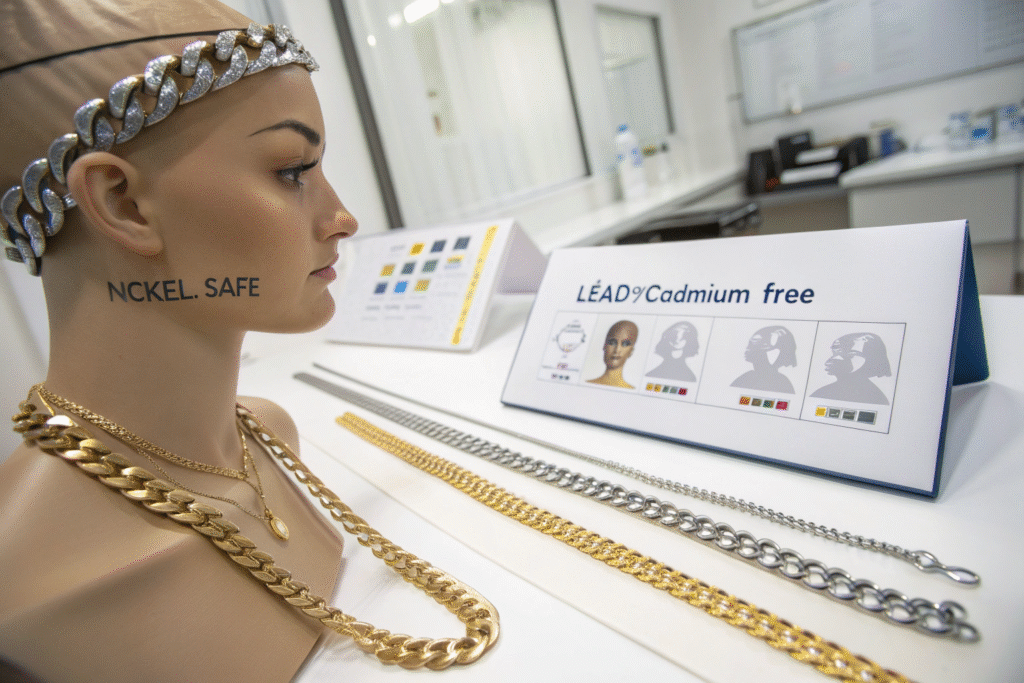
I like to break down REACH into simple steps. First, understand the scope for articles. Second, understand Annex XVII limits that hit jewelry-like items. Third, check the candidate list for SVHC risk. Fourth, test for nickel release. Fifth, keep records and traceability. Last, plan for customs review. Below, I add detail, links, and a practical table you can save.
What does REACH mean for hair chains today?
REACH applies to articles that release substances in normal use or contain restricted chemicals. Hair chains fall under jewelry-like accessories, so nickel release and heavy metal limits are key. You can read the official guide on Understanding REACH at the European Chemicals Agency here: ECHA Understanding REACH and see the legal base in Regulation (EC) No 1907/2006: EUR-Lex 1907/2006. I use these two pages when I train new sales engineers. They set the baseline for scope and duties.
Which restrictions are most relevant for metal accessories?
The most common issues are nickel release, lead content, and cadmium content under Annex XVII. The official Substances restricted under REACH list is here: ECHA Annex XVII Overview. When we choose a plating system, we confirm nickel-safe design at the start. If a supplier proposes a new alloy, we screen it against the Candidate List of SVHC: ECHA Candidate List. We update our risk assessment when ECHA adds substances twice a year.
Annex XVII quick reference table
| Focus area | What we check | Typical method | When we test |
|---|---|---|---|
| Nickel release | EN 1811 migration | Simulated sweat test | At PP sample, then per color lot |
| Lead content | Annex XVII limits | XRF + wet chemistry | Material change or annual |
| Cadmium content | Annex XVII limits | XRF + ICP | Material change or annual |
| SVHC >0.1% | Candidate List | Supplier DOC + lab | New material; SCIP if needed |
Material Choices for Nickel-Safe Hair Chains
I design hair chains with materials that pass EN 1811 first, then I chase color and finish. This order saves time. Stainless steel 304/316 can pass nickel release more easily. Brass with high-quality palladium barrier and gold or rhodium topcoat also performs well. Zinc alloy needs strict plating stacks and quality control. I choose welded rings over open rings to avoid micro-cracks that leak nickel.
When a client prefers a warm gold tone, I use a palladium barrier under gold to reduce nickel migration. When a client needs silver tone with low allergy risk, I use rhodium over a robust barrier. For budget lines, I propose stainless with PVD. It holds color and resists sweat. Below are the practical questions I answer with buyers on our first sample brief.
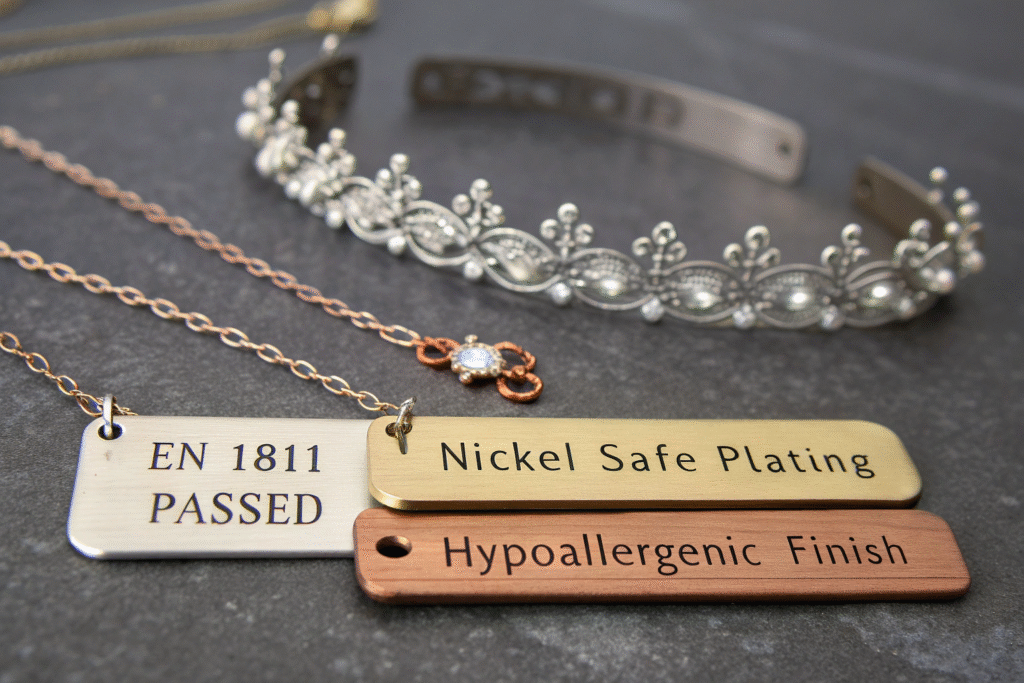
How do I pick a base metal that reduces nickel risk?
Start with target finish and price, then pick the base. Stainless 316 is stable and often passes EN 1811. Brass is good when you use a barrier layer. Zinc alloy is cost-effective but needs a stricter plating process. You can review the nickel release method in EN 1811 through standards guidance like BSI’s page on EN 1811: BSI EN 1811 Overview. For a wider EU chemicals framework, keep CLP classification in mind for substances used in coatings: ECHA CLP. We build the plating stack from these basics.
What plating stack works best for fashion and allergy safety?
I usually specify copper strike (if brass), then nickel-free or low-nickel buildup, a palladium barrier, and gold or rhodium top. For stainless, I like PVD for sweat resistance. For zinc, I demand tight porosity control. If you need third-party testing service over time, look at SGS REACH services: SGS REACH Compliance or Intertek REACH: Intertek REACH. These partners help when you need periodic checks for e-commerce audits.
Material vs. Finish matrix
| Base | Pros | Watchouts | Best use |
|---|---|---|---|
| Stainless 316 | Low nickel release, durable | Color options need PVD | Sport, daily wear |
| Brass | Rich plating quality | Needs barrier layer | Premium bridal |
| Zinc alloy | Low cost, flexible shapes | Porosity, plating QC | Trend drops |
| Copper | Warm tone | Tarnish risk | Vintage looks |
Testing, Certification & Documentation Checklist
Testing is not a one-off task. I treat it as a calendar. I define which SKU and which color to test at PP approval. I repeat when we change materials or change platers. I also do sample surveillance on hero SKUs every six months. I store all reports by SKU-color-lot so our shipping team can submit them fast when customs asks.
Documentation wins time at the border. We prepare a compliance dossier that includes the Annex XVII statement, EN 1811 test report, heavy metals screening, and supplier declarations. If any SVHC goes above 0.1%, we prepare SCIP notification. We align labels and packing marks. We keep Incoterms clear in the PI to avoid responsibility gaps.
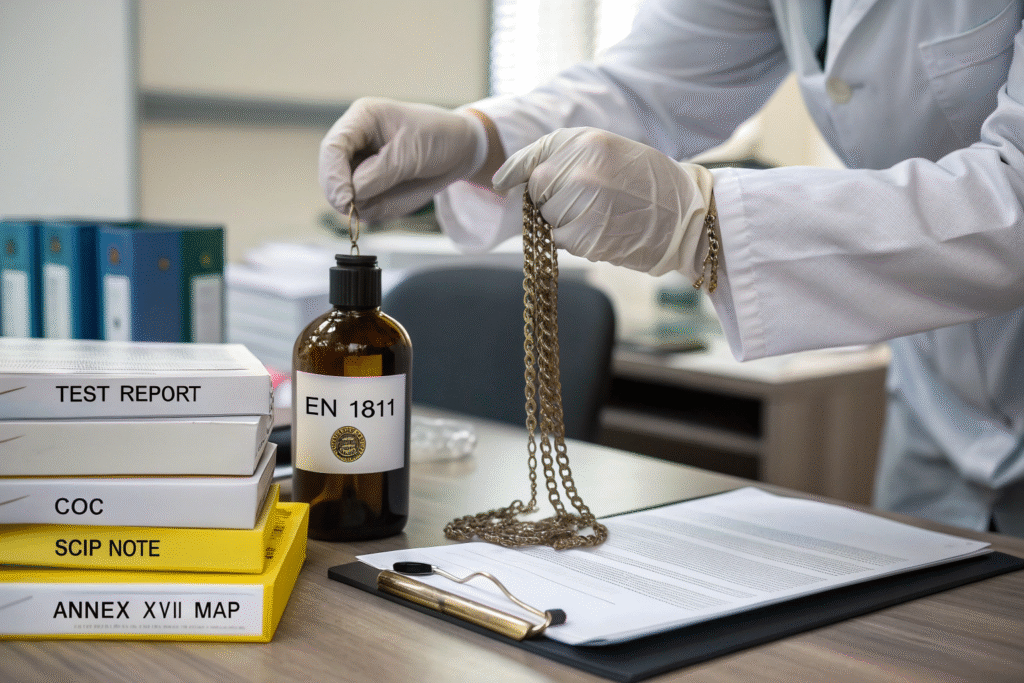
Which test methods and certificates do EU buyers expect?
EU buyers expect EN 1811 for nickel release and screening for lead and cadmium per Annex XVII. Some request ongoing XRF screening at incoming QC. You can learn about Annex XVII on ECHA: ECHA Annex XVII. For broader, practical testing support, TÜV SÜD outlines REACH services here: TÜV SÜD REACH. We also work with in-country labs for faster retests before peak season.
What documents should I keep for each SKU and color?
I keep a test plan, the latest EN 1811 report, heavy metals report, supplier declarations, plating stack sheet, and shipment records. If a substance of very high concern applies, I follow the SCIP database rules: ECHA SCIP. For packaging and waste rules, I monitor the EU page on packaging waste to set packaging material choices: EU Packaging Waste. This file set supports audits and marketplace onboarding.
My working checklist
| Phase | Owner | Output |
|---|---|---|
| Design | Sales + R&D | BOM, plating stack |
| PP test | QA + Lab | EN 1811, metals screen |
| Production | QC | Incoming XRF, line checks |
| Pre-ship | QA | Golden sample, doc pack |
| Post-ship | CS | Archive reports, feedback |
EU Import, Labeling, and Logistics Best Practices
When I talk with buyers, the pain point is not only price. It is timing and paperwork. I solve this with clear labels, harmonized tariff lines, and a standard doc pack in the outer carton. I pick forwarders who understand fashion accessories and who can pre-alert customs with the right codes. I also plan buffer on sea schedules during peak season.
I use cartons sized for e-commerce prep lines. I mark inner bags with SKU-color-size sets. I include spare jump rings and spare clasps to reduce returns. I also set moisture control in each carton. For EU, I align HS codes with invoice and packing list. I add a short REACH statement on the CI footer. For DDP lanes, I bake duties into the offer for stable cost.
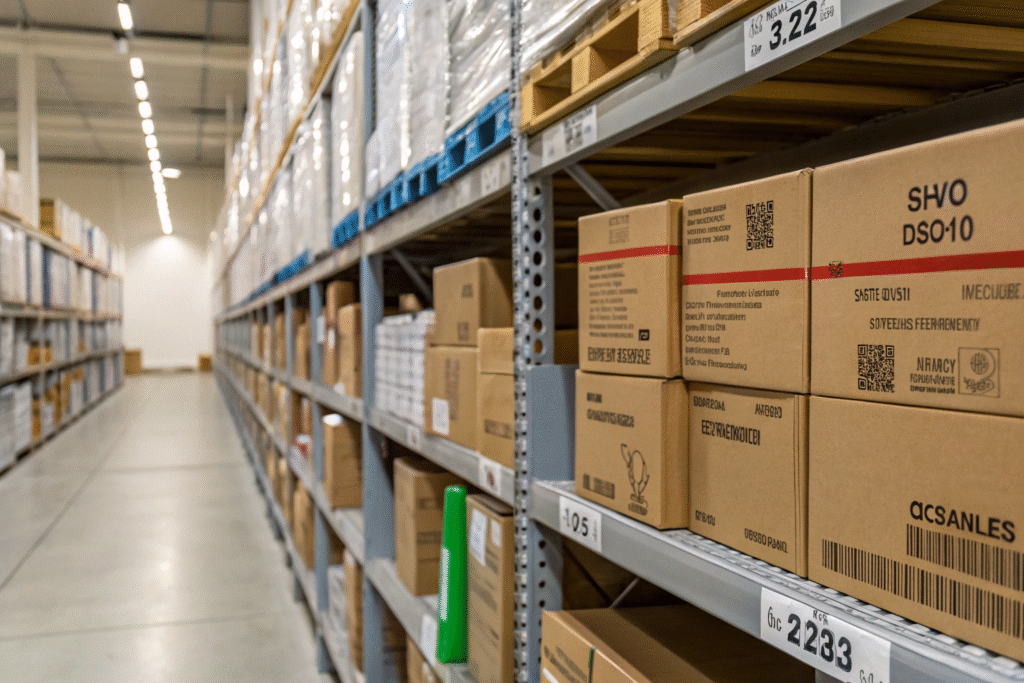
How do I prepare for customs and tariff classification?
I align the product description with the HS code the client uses. I avoid vague words. I add materials and main use. You can review EU TARIC for current tariff info here: EU TARIC Overview. I also track alerts via the Safety Gate (formerly RAPEX) to see trends in non-compliance for jewelry items: EU Safety Gate. This helps me prevent avoidable stops.
What labeling and marketplace notes should I follow?
I keep labels simple. I show material, country of origin, and care note when needed. For chemical content claims, I only print what I can prove. If a marketplace asks for extra proof, I share EN 1811 and Annex XVII results. For broader RoHS-like issues in electronics accessories, you can check EU RoHS guidance: EU RoHS Directive. For UK shipments, I also check UK REACH guidance: HSE UK REACH.
Logistics and Incoterms table
| Scenario | Term | Why I choose it |
|---|---|---|
| First trial order | DDP | Simple landed cost |
| Repeat stable lane | FOB | Buyer controls freight |
| Urgent restock | DAP Air | Fast, buyer pays duty |
| Multi-EU DCs | DDP + split | Cost visibility |
How We Run Quality Control Without Slowing You Down
I built a QC system that matches fashion speed. I use welding where possible and stronger jump rings to reduce breakage. I check porosity before plating. I run pull tests on clasps. I run cross-hatch adhesion tests after plating. I use XRF at incoming to screen lead and cadmium. I lock color with master chips so reorders stay consistent.
I share a one-page dashboard per order. It shows lot numbers, inspection results, and sample retention photo. I also keep a change log for suppliers and finishes. Buyers like Ron want predictable outcomes. This is how we deliver them. My goal is to help you launch on time and avoid after-sales problems.
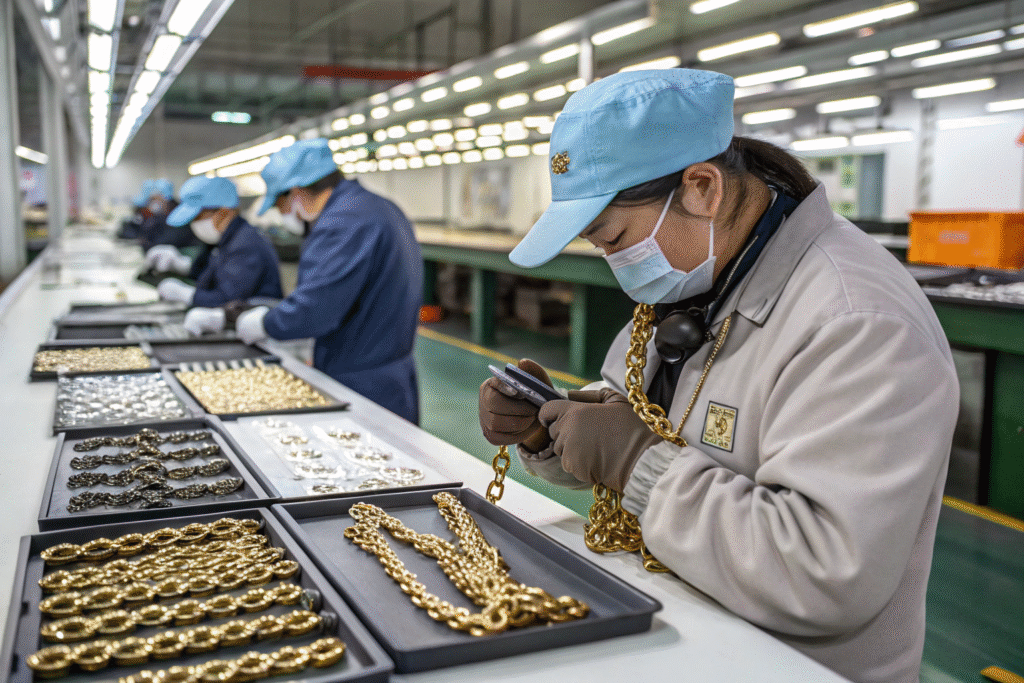
Which inline tests actually prevent failures?
Pull test, salt-sweat simulation for high-sweat users, adhesion cross-hatch, and weld integrity checks stop most returns. For lab partners and best practice, see OEKO-TEX overview for textile-related risk controls: OEKO-TEX Official. For social compliance, I align with amfori BSCI to keep ethical production visible: amfori BSCI. These do not replace REACH, but they show a stable management system.
How do I maintain traceability across factories?
Each sub-factory—dyeing, printing, embroidery, packaging—feeds a lot code into our ERP. I store supplier declarations and plating batch sheets by lot. I attach test reports to each lot folder. If any SVHC change triggers an update, I refresh the REACH statement. You can read how the Candidate List updates work on ECHA: ECHA Candidate List. For Incoterms in contracts, I use the ICC Incoterms reference: ICC Incoterms 2020.
Inline QC plan snapshot
| Step | Tool | Target |
|---|---|---|
| Weld check | 10N pull | No failure |
| Plating porosity | Porosity test | Zero pinholes |
| Color control | Master chip | ΔE ≤ 1.0 |
| Final audit | AQL 2.5/4.0 | Pass |
Conclusion
I showed how I source and manufacture hair chains that meet REACH for EU markets. I started with materials that pass EN 1811. I then mapped Annex XVII risks. I built a test calendar and a clean document pack. I aligned shipping and labeling with EU practice. This is how I keep product quality high and timelines short.
If you are planning a private label hair chain line, I can start with free concept sampling and a clear compliance plan. We can run a pilot with stainless or brass options, then scale with stable plating. To start, please contact our team at Shanghai Fumao. You can email our Business Director Elaine: elaine@fumaoclothing.com. We will prepare options that fit your price point and your launch date.

